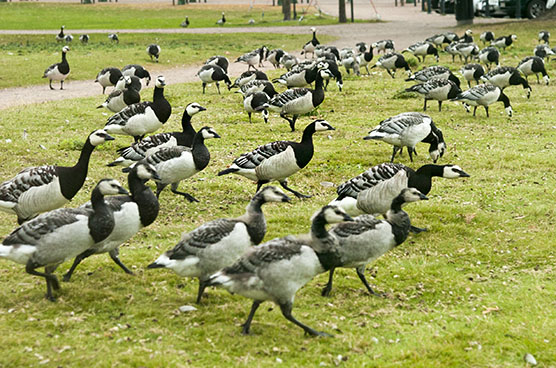Press release 2013-08-05 at 12:12
The number of barnacle geese grazing on the park lawns of Helsinki and Espoo has remained unchanged compared to 2012. This year, researchers from the Finnish Environment Institute (SYKE) counted a total of 3,579 barnacle geese, 640 of which were goslings. Due to record-large broods, the number of goslings increased by 15 per cent year-on-year.

Photo: Riku Lumiaro
In the counting performed at the end of July, the largest barnacle goose populations in Helsinki were found in Suomenlinna (463 birds), Harakka (287), Korkeasaari (251), Kaivopuisto (248) and Arabianranta (173) and at the mouth of Vantaanjoki river (141).
In Helsinki, 60 per cent of adult geese and 50 per cent of goose broods were concentrated in Kruunuvuorenselkä bay and its immediate surroundings. There were 34 broods in both Kaivopuisto and Suomenlinna. The third important brood concentration was found at the mouth of Vantaanjoki river and in Arabianranta, where the brood count was 38.
In Espoo, there was a total of 190 birds, representing only one third of last year's total. The number of broods found in Espoo also decreased to a third compared to 2012. Seven broods were discovered in Otsolahti bay and one in Silkkiniitty park. While Espoo accounted for approximately 22 per cent of the late-summer barnacle geese populations in the Greater Helsinki area in 2005–2010, over the past three years its share has fallen to a mere 5 per cent.
North of Länsiväylä highway, barnacle geese are concentrated in the shore areas of Seurasaarenselkä bay and east of Laajalahti bay, where 20 per cent of the total number of broods were found. In the Greater Helsinki area, the total number of broods (259) was up by only four from last year, but the average brood size was a record high, at 2.5 goslings per brood as against 2.3 in 2006–2012. With the warm early summer, the broods have done well.
Barnacle geese are picky eaters
The effects of barnacle goose broods grazing on grass areas have been monitored over a few summers. Barnacle geese are picky eaters, which plays a part in influencing shore vegetation. Plants that they avoid eating, such as silverweed, may become more abundant, although this has not been detected in all goose grazing areas.
In some areas, however, the eating habits of barnacle geese have been noted to cause a decline in the diversity of flora. Erosion of vegetation has also been observed in various locations due to geese feeding and trampling there. Geese graze relatively close to the shore if the grass remains attractive for them in terms of variety of species.
With grass quality deteriorating and plants avoided by barnacle geese becoming more abundant, broods must venture further inland to feed. This has happened, for example, on the fortress island of Suomenlinna, where some geese have begun to graze on the ramparts.
For further information, please contact:
Markku Mikkola-Roos, Senior Researcher, Finnish Environment Institute SYKE,
tel. +358 (0)400 148 685, firstname.lastname@ymparisto.fi
Maarit Leppänen, Researcher, University of Helsinki,
tel. +358 (0)400 689 769, maarit.leppanen@helsinki.fi
Riku Lumiaro, Communications Expert, Finnish Environment Institute SYKE,
tel. +358 (0)40 509 8654, firstname.lastname@ymparisto.fi